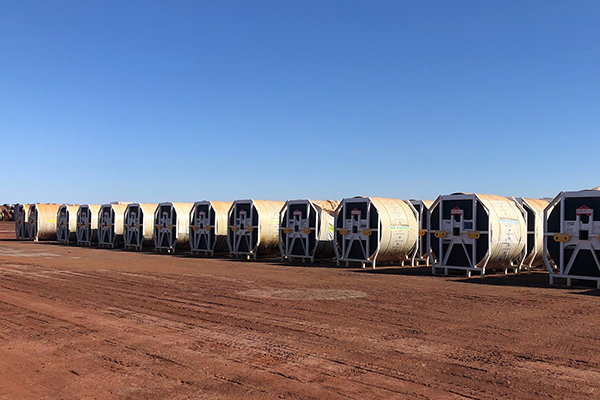Boosting conveyor energy savings and sustainability
Published in Australian Mining
Fenner Conveyors' next generation of PowerSaver LRR conveyor belt compound creates further energy savings and reduces capital expenditure in the process. Australian Mining takes a closer look.
Fenner Conveyors is placing a greater emphasis on conveyor research and development (R&D) than ever before, resulting in more efficient and more forward-thinking products.
The PowerSaver low rolling resistant (LRR) rubber conveyor belt compound is a clear example – a product that is helping operators simultaneously drive down costs and CO2 emissions.
Since the first generation was launched in 2018, Fenner has supplied more than 140km of the PowerSaver product to the market.
Fenner engineered conveyor solutions (ECS) manager Mike Finlen said PowerSaver answers the call for a more energy-efficient belt compound.
“Many mining projects typically have long, overland conveyors and, from a capital cost perspective, they’re interested in reducing power demand on those conveyors,” he told Australian Mining.
“There’s also a growing focus on conveyor efficiency from an energy-consumption point of view, where mining companies are trying to be greener. PowerSaver helps them achieve this.”
The PowerSaver compound is applied to the bottom cover of the conveyor belt. It achieves power savings by minimising cover indentation on the pulley cover, helping with easier flow over the idlers. This leads to less friction and more efficient conveying.
Finlen said PowerSaver’s ability to reduce operating tensions and drag on the conveyor means mining companies can downsize their drives and pulleys, reducing their capital expenditure (capex) in the process.
“When we’re talking about conveyors that could be over 20km long, there’s significant cost savings to be had,” Finlen said.

PowerSaver was developed specifically for the Australian market, mindful of the requirements of the major iron ore, bauxite and coal miners, who are the main operators of overload conveyor systems.
The flagship PowerSaver project was developed in collaboration with a major iron ore miner in Western Australia, with the belt compound installed on a series of overland conveyors. The mining company put PowerSaver through extensive acceptance testing before Fenner was contracted. This involved sending the product to the US.
“Prior to finalising us as a supplier, the customer asked to have samples of PowerSaver sent to Conveyor Dynamics Inc. in the US to undergo a validation process,” Finlen said.
“Once the results came back and the performance of PowerSaver was proven, the customer had confidence that PowerSaver was a leading material and could achieve its power consumption targets.”
This first generation of PowerSaver was so successful it became a benchmark for low rolling resistant compound standards in Australia.
Fenner rubber R&D manager Upul Silva said while the first-generation PowerSaver can achieve up to a 20 per cent energy saving on a conveyor belt, the second-generation product can achieve a 40 per cent energy reduction.
PowerSaver 2.0 was launched in 2020 following extensive testing and analysis to ensure it complied with the relevant Australian Standards.
This began with a small-scale dynamic mechanical analysis (DMA) to characterise the development compounds before large-scale testing was conducted on an indentation rolling resistance test rig. This was done in partnership with the University of Newcastle Research Associates (TUNRA).
Silva said when the PowerSaver 2.0 was being developed it was the first LRR compound to be tested at TUNRA using the then-new Australian Standard 1334.13.
“The PowerSaver 2.0 compound was developed using specialty polymers, specialty carbon blacks and novel materials,” he told Australian Mining. “It also utilises new mixing techniques to get the optimum compound mix and performance so that we can deliver the best outcomes for our customers.
“There was a lot of work done in the laboratory and in production to try and get that final compound mix right, which has resulted in us developing the best performing compound possible.”
Finlen said that manufacturers previously had to trade-off between achieving a reduction in indentation rolling resistance and maintaining the compound stiffness to ensure durability of the product.
But PowerSaver 2.0 has been designed to achieve both of these variables.
“In the past, when a more energy-efficient product has been developed, there’s been reduction in material toughness,” Finlen said.
“One of the things we were very conscious of in developing PowerSaver 2.0 was to not have that level of compromise. We quantify this by a characteristic known as dynamic shear modulus at low strain.
“With PowerSaver 2.0, we achieved a 50 per cent higher dynamic shear modulus at low strain compared to previous compounds.”
Some of the inspiration behind the PowerSaver 2.0 has come from Fenner’s parent company, Michelin, which has global resources and places a particular emphasis on R&D.
“Since we joined the Michelin Group in 2018, we’ve been collaborating and sharing data with the company,” Silva said.
“Michelin has 3000 employees at its R&D centre in France, where it develops its own specialty polymers, and I’ve worked closely with Michelin’s material and rolling resistance experts to develop PowerSaver.”
Having successfully launched the second generation of PowerSaver, Silva said Fenner and Michelin have been working on the third generation of the product for at least a year. The two companies hope to have PowerSaver 3.0 ready by late 2023.
“PowerSaver 3.0 will have further improvements to rolling resistance and the shear modulus,” Silva said.
“It’s important for us to continue driving the performance that our customers desire so we are not resting on this compound.”
Fenner and Michelin have also been experimenting with sustainable materials, which will underpin the development of all future Fenner compounds, including the PowerSaver.
As per Michelin’s sustainability goals, the company and its subsidiaries will need to be producing compounds made up of 100 per cent sustainable material by 2050.
While limiting capex is critical to insulate companies from the current inflationary environment, the mining industry cannot be lost on the broader net-zero imperatives.
Luckily enough, PowerSaver can achieve both goals.
This feature appeared in the November issue of Australian Mining.